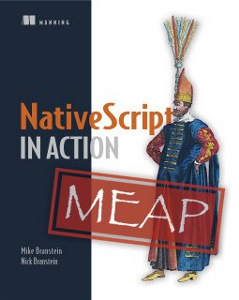New book: NativeScript in Action - First Chapter Free!
This is a guest post from Mike Branstein, one of the authors of "NativeScript in Action"
Nick Branstein, my team at KiZAN Technologies, and I have been following NativeScript very closely since early 2015. Between beta testing, hosting Summer of NativeScript meetups, personal and work projects, workshops, and conference talks we grew to love NativeScript. After a year of NativeScript in our blood, it all culminated in something I really never considered: write a book.
 On March 13, 2016, NativeScript in Action was born and the Brosteins (Nick Branstein and Mike Branstein…yes, we're brothers) became authors.
On March 13, 2016, NativeScript in Action was born and the Brosteins (Nick Branstein and Mike Branstein…yes, we're brothers) became authors.
When we started, Nick and I talked about various motivations for writing NativeScript in Action. I wanted to write NativeScript in Action for several reasons: to make a contribution to the NativeScript community and share my love for NativeScript with others.
We've found that writing is hard. Sure, we had a plan, a rough table of contents, and generally knew the technical aspects we needed to cover, but we didn't know exactly who the book was for and how we were going to teach NativeScript to our readers. But, we figured it out. Through writing the first several chapters, we discovered our reader. We also found the best way to teach NativeScript is by combining code samples, real examples, and related images together to help our readers build a working model of NativeScript in their head.
NativeScript in Action is organized into three different parts, with the first part encompassing three chapters.
Chapter 1 begins with a brief overview of NativeScript, how it works (at a high-level), how it compares to other mobile development frameworks, and why you may choose to use NativeScript. Because we’ve targeted the book towards a broader audience, we purposefully do not dive deep into the internal workings of NativeScript. Although the internals of NativeScript are certainly interesting (especially if you are the type of developer who loves to know what is going on behind the scenes), they could distract readers and take their focus away from what we believe our mission to be: empower developers to build amazing apps with NativeScript.
Chapters 2 and 3 dive a little deeper into NativeScript, exploring how NativeScript apps are created, built, and run using the NativeScript command line interface (CLI) tools. We also explore how NativeScript uses a variety of conventions to make mobile development easier.
Parts two and three of the book take you through building three different mobile apps, which are representative apps a new mobile developer may build to showcase their knowledge. By the end of NativeScript in Action, you will be able to write a multi-page mobile app with complex user interface designs and use data binding with remote web service calls to create dynamic content pages within your mobile apps. You will also learn how to write a single app with dynamic user interface layouts that can be deployed to devices with varying sizes, screen resolutions, and platforms (such as an iPad, iPhone, Android phone, and an Android tablet).
We nearing the half-way point in writing NativeScript in Action, and would love your feedback. This is a book for the community and developers looking for a different (and potentially better) way of developing truly native mobile apps with JavaScript. Community feedback and engagement is incredibly important to Nick and I, and it will make NativeScript in Action a better book. Check out an early-access preview of NativeScript in Action, where you can get the first chapter free.